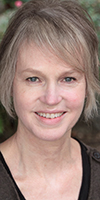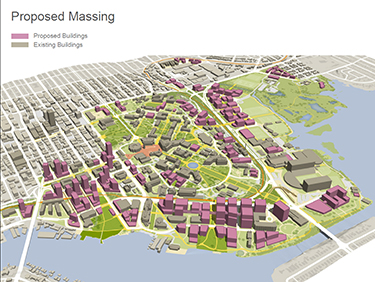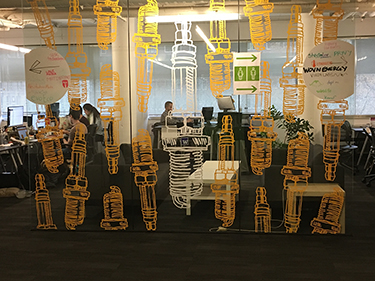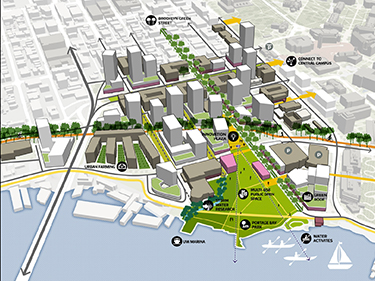|
Subscribe / Renew |
|
|
Contact Us |
|
| ► Subscribe to our Free Weekly Newsletter | |
| home | Welcome, sign in or click here to subscribe. | login |
Architecture & Engineering
| |

|
|
Design Perspectives By Clair Enlow |
February 17, 2016
Design Perspectives: UW eyes 8 million square feet of new buildings
Special to the Journal
Next month the University of Washington light rail station opens, and Sound Transit expects that before 2030 as many as 25,000 people will be boarding trains there daily.
They'll walk high above the congested roadway on their own pedestrian bridge that connects directly to the central campus. The station will be four minutes from Capitol Hill, and eight minutes from downtown Seattle.
Now the UW is beginning to share information about its future plans with the city of Seattle as it seeks approval of a new zoning overlay for construction within its boundaries. The planning process is expected to last through 2017.
This could be big. The UW wants to add up to eight million square feet of new construction over the next 20 years. That's about five Columbia Centers. The new space would accommodate 17,000 more students than the UW's 2014 population, which is just under 44,000.
Increasingly the UW is looking like a city-within-a-city, and it's acting like one. It will be asking city officials to increase height limits to 300 feet in certain areas of campus west of 15th Avenue Northeast, where a few buildings now are just over 100 feet, according to UW planner Theresa Doherty.
At the same time, the UW is embracing green areas along Portage Bay and its 2.5-mile shoreline. It favors better views and pedestrian pathways that will connect campus to shore, and also reach deep into the street grid of the surrounding neighborhood. If open spaces are the lungs of a city, the UW and surrounding streets will be breathing more freely.
Startup city
All that growth has to go somewhere. In the next decades, UW construction is likely to cluster first on West Campus, a 60-acre part of the 643-acre UW campus. West Campus is west of 15th Avenue Northeast, around Northeast Campus Parkway.
Why is growth going there? Because the bones of the iconic Central Campus must be respected, and its open spaces preserved. The vast parking lots of East Campus (anchored by Husky Stadium) are on soft ground because of an old landfill. South Campus, home of UW Medical Center, is already largely built out, although some of those buildings are likely to be replaced with larger ones.
West Campus is favored almost by default. It's rapidly turning into a neighborhood where most of the population is under 25. In the past decade, it's become a student housing village. Seven new buildings centered on Northeast Campus Parkway bring the UW's bed count in West Campus to over 5,000, and offer a lot of services. There's a new grocery store in the neighborhood, a police station, and even a new power plant on the way.
West Campus is poised to become a buzzing hub of innovation, a neighborhood where people shop for groceries, drop off the kids and invent the next killer app, all within couple of blocks. If Microsoft moved into Seattle, it couldn't do much better than this in building a neighborhood.
The area will test an idea at the heart of the UW's vision for growth: the “innovation district.” The concept will mix private industry with education and make the university a hotbed of marketable ideas. UW officials clearly hope to make their public institution even more competitive with large private universities like Harvard, MIT and Stanford.
The idea started in biotech, with private companies outsourcing research to universities, and then spread to the high-tech industry. In centers like West Campus, the UW hopes to blend innovation with everyday life, and even arts and cultural pursuits.
Near the heart of West Campus is Condon Hall, a 1970s concrete structure that used to house the UW School of Law. It now holds the “surge” population that has been displaced from UW buildings being remodeled or rebuilt.
On the second floor of Condon Hall is an experiment called Startup Hall. It's a shared work area with conference space as well as rooms for meetings or quiet concentration. The population increases in the afternoon and evening as people gather at computers and huddle at tables, drinking free coffee (courtesy of Starbucks).
Startup Hall doesn't feel slick or corporate. Nor is it an incubator. Startups here pay rent just as they would in shared workspaces around the city. But they get to pitch their products to larger companies in hosted events, on and off site, and some have gone on to rent their own spaces in Seattle. It has been open for a year and a half, and competition to get into Startup Hall is way up, according to Nathan Daum, who manages the space. Expect to see more spaces like this in UW's future.
Corporate model
The drive for an innovation district is fueled, in part, by the urban location of the UW and its ties with the rapidly expanding tech and biotech sectors. It's also spurred by shrinking support from the state of Washington.
In planning for growth, the UW is just acting like other institutions of higher learning, public and private. It's behaving like a private corporation. Growth means competing with other institutions to attract the most talented professors and students.
The UW is doing the best it can with what it has — and doing very well, indeed. Last September, Reuters named UW the world's most innovative public university, a ranking based on things like academic papers, research grants and contracts, and startups.
According to Reuters, the UW receives more federal research funding than any other U.S. public university. Grants and contracts in 2014 amounted to $1.39 billion, and $1.08 billion of that came from federal sources. In 2014, 18 new startups based on UW research technologies were counted — a record year for the institution. The 10-year total for UW is 103 technology startups.
Room of their own
In the meantime, U District residents next door to the UW don't want to just survive in the shadows. The U District Station will open on Brooklyn Avenue, south of 45th Street, in a few years when the light rail line is extended to Northgate. The station is near West Campus but outside the boundaries of the UW campus. It was once seen by U District residents, spurred by longtime UW architecture professor Phil Thiel, as the ideal spot for an open space or plaza that would belong to the neighborhood.
But ironically the station is likely to be built-over by the UW. Way over. The UW purchased air rights above the underground station from Sound Transit, and now awaits zoning decisions from the city about how much and how tall it can build.
As the U District scrambles for its own identity and resources, it finds a voice in activist groups like U District Square, which advocates for open space in the U District that's separate from the UW campus. Members of the City/University Community Advisory Committee also support a plaza in the U District.
It's the city's role to be the grownup in meetings with the UW and U District residents. In the meantime, as the university grows by leaps and bounds, neighbors can hope that the UW will behave even more like a city — and help the neighborhood find a room of its own.
Clair Enlow can be reached by e-mail at clair@clairenlow.com.
Previous columns:
- AIA winners manage to surprise and inspire, 11-18-2015
- Design Perspectives: 2&U tower's design team attempts a heavy lift, 11-12-2015
- Design Perspectives: Budapest, Vienna offer lessons on planning and war, 09-30-2015
- Design Perspectives: Two Seattle tower designs that flaunt their height, 08-26-2015
- Design Perspectives: Now let's review Seattle's design review, 08-12-2015
- Design Perspectives: Seattle Aquarium swims over toward the market, 07-01-2015
- Design Perspectives: In Chophouse Row, archaeology meets architecture, 06-10-2015
- Design Perspectives: Hotel/apartment will transform First & Stewart, 05-27-2015





